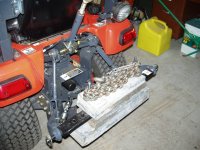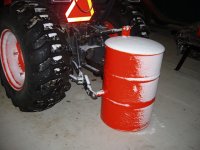poldies4
Silver Member
This is kind of a continuation of an earlier thread. I as well as the other gentleman was sold a tractor with FEL and told loaded tires was sufficient ballast for my BX 1860. Thankfully i'm on TBN ALOT, and learned many good reasons to have ballast, other than keeping rear wheels on the ground. My dealer who staunchly defended the need for either one or the other, and really pushed the loaded tires, assured me that a ballast box or other 3pt weight was absolutley not needed. After a few discussions with him, and weeks of trying to find affordable ballast that was useful, I went to the deere dealer an bought a green one. I'm sure my dealer will be a little more digruntled when he drives by and see's the green box. He said "sure, i'll sell you one, but it's a waste of money, you don't need it". Plus he wanted 60 dollars more than the deere guy. At any rate, my question is are loaded tires ok to have with ballast box? Should I get rid of the beet juice, or keep it. My buddy bought a deere yesterday, his dealer said that loaded tires and ballast box was no good. It's amazing to me how many opinions they're are out there. Every dealer i've talked to has a differing opinion than the next. At any rate the moral of the story for me is that the ballast box has made a huge difference in how the tractor performs. I didn't realize how underweighted the rear end was until I had some weight behind the 3pt. When I loaded the box out of my truck into the loader I had to slowly back up a small slope to back into my barn. I figure the box itself weighs 125 lbs or so, maybe less. The next thing that happened really surprised me. With my loaded tires that the dealer assured me was plenty, and appropriate amount of rear ballast, low gear with only 2wd my back tires started to spin on the concrete. So with 125lbs, which is no where near the weight of a full bucket, a small slow incline, my traction was gone! I know that 4wd would have popped me right in, but I was testing some of the advice I was given. You guys on TBN give impartial real advice and those of us that are new to the tractoring, at least me, really appreciate it. So in my very green opinion, ballast might be one of the most crucial parts of FEL operation. I can't remember who said it, but some one on TBN stated that it's like driving on velcro, he was right!!!!!



